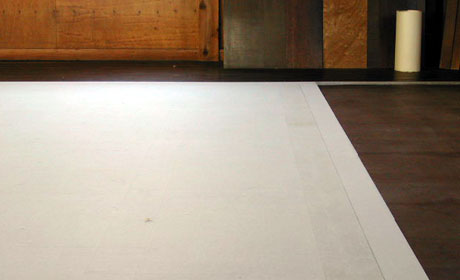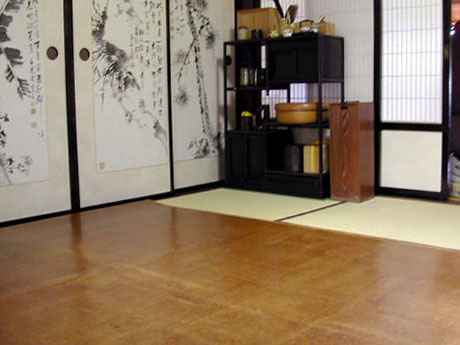
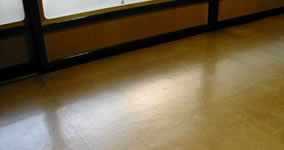 |
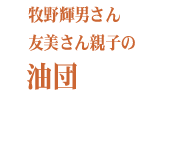 |
The
yuton of Teruo and Tomomi Makino
It
was after coming across this haiku poem by Takahama Kyoshi that
I first started to wonder about yuton. I found out that yuton
were made of paper, but what sort of paper product could have
a surface so shiny that it would even reflect the pillars inside
a house. I wanted to see one for myself, so I went looking.
|
||||
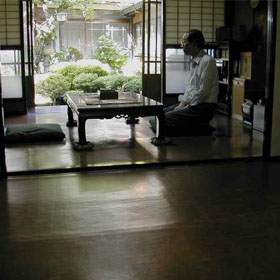
|
|
|||
|
Only one shop remains in Japan that makes yuton any more -- the scroll mounting shop Beniya Koyodo in Sabae City, Fukui Prefecture. The master craftsman there is Mr Teruo Makino. His son Tomomi works with him to make yuton as a side business. I went to their shop and they showed me part of the yuton making process. The Makinos only make yuton once a year, between April and June, and I was extremely lucky to be there just as they were starting on a six-mat one -- their only yuton for the year. Yuton are a lot of trouble to make and require a large space inside as well as roof space to dry, which is one reason why the number of people making them has dwindled so dramatically. But another reason that yuton have disappeared from our lives is the unbearable nature of the Japanese summer. If you live in the city, it is like a furnace outside, with no relief to be gained by opening a window. As a result, people find they can no longer live without air conditioning. Of course we all know that this is not good for our own health, let alone being bad for the environment. But first let me give you some idea of how the Makinos transform raw sheets of handmade paper into beautiful floor coverings. |
||||
The thud of the brush Stepping into the workshop I hear a rhythmic thudding that seems almost to reverberate through my body. Going up to the second floor I find Mr Makino's son, Tomomi, pounding the edges of a sheet of pure white paper spread out on the floor with a thick brush. The process of making a yuton begins by coating a sheet of handmade washi paper, which acts as the base of the mat, with persimmon juice and then pasting down several layers of umbrella making paper made of 100 percent paper mulberry. This is done by joining the 70 x 50 centimeter sheets of umbrella paper side by side on the base and beating them to make each adhere firmly. The thick beating brush used for this job is made of hemp palm. Sitting on his haunches, the craftsman needs considerable strength and stamina to keep up this beating action, bringing the brush down firmly and strongly perpendicular to each sheet. The beating action forces the fibers of one sheet of paper to actually meld with the next, which is the secret behind the yuton's overall strength. |
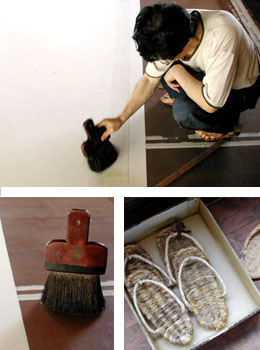
|
|
| The craftsmen
paste together about 13-15 layers to make a yuton. One person applies
glue while the other pastes down and beats, a job that requires
skill and precise team play. And there is no room for error in the
amount of glue applied to each sheet. This has been the wives¡ job
for generations. The one who pastes down the paper must stand on
top of it to work. He cannot do this barefoot because any sweat
would damage the surface, and he cannot wear slippers because they
do not have enough traction. The footwear of choice is sandals made
of bamboo skin. There is a fine art in ensuring that each piece fits as perfectly as possible without any overlap at the edges -- a skill in which Mr Makino was trained endlessly by his father. Even with a mat as big as eight-mat size -- 360 centimeters square -- Mr Makino can keep his overlap within 3 mm. Quite an achievement. And he does this without drawing a single line to keep the paper straight, just using his eyes and his craftman's instinct to guide him. They say in handcraft that the simpler the task, the harder it is to do well, and this is certainly the case with yuton. Such precision is indeed the very basis of fine hand craft. |
||
Red strips at the window The number of layers of washi paper used depends to some extent on the ply of the paper but usually 13-15 are layered, after which the whole mat is coated with perilla oil by hands with a piece of cloth. The perilla oil needs to be heated and is very hot to touch when applied. Two applications of the oil on the surface while the underside is lightly coated with persimmon juice. |
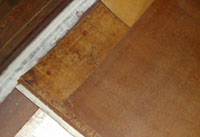 |
|
| Then comes
one of the hardest parts of the whole process: carrying this bulky
10-square-meter sheet of oil-soaked paper up onto the roof to dry.
The Makinos aim for a day that is supposed to be fine and then three
of them lug the heavy yuton up onto the roof. This is one reason
why they try to finish making all their yuton before the rainy season
sets in, in June. They have experienced having a yuton slip off
the roof and becoming damaged too badly to repair. Another enemy
is birds. Damage from bird droppings cannot be repaired. So they
hang strips of red cloth from a wire stung up on the roof to keep
the birds from landing and after that just pray that there are no
droppings from above. Even in the windows of the workshop they have hung strips of red cloth --also to stop birds coming in, since they must work with the windows open. However the Makinos tell me that now that they are getting older they have started trying to dry the yuton as much as possible indoors. When autumn arrives people who own yuton usually roll them up and put them away until the following summer. When they are unrolled again in the summer they are likely to curl up at the edges and trip people, so special metal pieces have been devised to hold the edges down. This will not happen with a well-made yuton, however, which are made with only the very best washi paper and well soaked with oil. The Makinos sometimes repair used yuton. The yuton they have handled range from ones that are still entirely unblemished, to ones that are ragged and full of holes. The life of a yuton certainly depends on the amount of care they receive. |
||
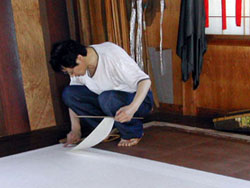 |
The yuton that the
Makinos make fit perfect over tatami mats and do not curl up at
the edges. Mr Makino showed me a yuton that has been used for
30 years. He had just brought it out and opened it up on the floor
the day before I came. It was perfectly aligned and lay flat on
the tatami where it reflected the green of the garden and the
sunlight in its shiny surface. I had never seen a paper product
like this before. Finely woven wisteria mats that have a patina
of age are extremely beautiful objects, as are clear-lacquered
solid zelkova wood floors but I must say there is nothing quite
as lovely as the yuton for covering the floor in a tatami room.
|
|
|
To continue making
or not |
||
|
|
